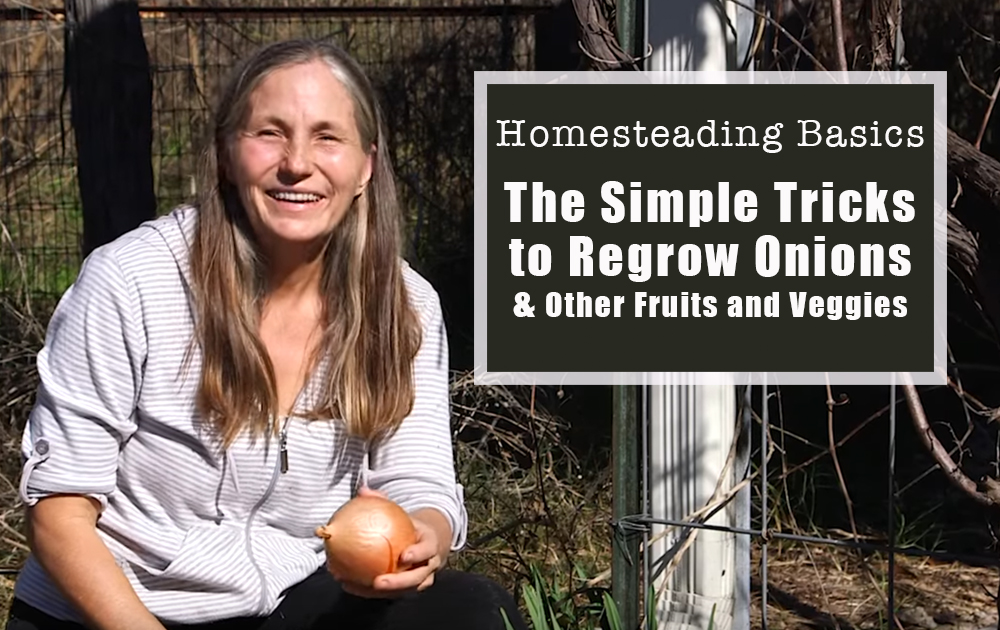(Length: 2:32 minutes)
On this edition of Homesteading Basics, I’m going to show you a really simple tip to regrow onions from the scraps.
Who doesn’t love onions?
I cook with onions, and we all know that when you’re getting ready to chop your onion, you cut the ends off. You cut off the top and the bottoms.
On that back end, where the roots are, you’ve got just a little bit of a scab. Here’s the tip: You can actually plant this, and it will regrow.
Take the scab of the onion. Put it in some dirt, and leave it there.
I’ve been doing this for the past couple of weeks. Look, you can see that some have already sprouted. Now, this is not going to make a whole new onion bulb, but rather beautifully small onion that looks a lot like a shallot. You can chop them up, and put them into soups and salads. They have that nice onion taste.
Another really great thing about this, they’ll become onion plants that sprout those big, beautiful allium flowers. They are very decorative.
This is a green that’s going to grow through the winter. The time to regrow onions is when it is moist and cool outside.
See…you’ll be able to get way more out of that onion than you first thought.
Other foods that you can grow from scabs
Simple and easy-to-regrow!
Place the root end in a jar of water and watch it regrow in a few days. Just make sure to replace the water every couple of days or as needed.
- Spring onions
- Leeks
- Scallions
- Fennel
Smells so good!
- Lemongrass
Regrow lemongrass exactly the same as the spring onions and leeks, but wait to harvest it until it is about 12 inches tall.
To the roots…
- Turmeric
- Ginger
Plant a small chunk of either ginger or turmeric in well-drained potting soil about two inches below the surface. Ginger and Turmeric like indirect sunlight in a warm, moist environment. The shoots and roots will begin to regrow in a few days. Once the plant is established, harvest by pulling up the whole plant, including the roots. Remove a piece off of that plant. Replant it to repeat the process or regrowing your ginger and turmeric.
- Potatoes
Choose a potato that has a lot of good eyes. Cut it into 2-3 inch pieces. Each piece should have 1 to 2 eyes on it. Allow the cut pieces to sit at room temperature for a day or two. This will allow the cut areas to dry. Potato plants thrive on a high-nutrient environments, so be sure to add a lot of compost before planting your potatoes. Plant your potato pieces about 8 inches deep with the eye facing up. Cover the pieces with 4 inches of soil. Leave empty space above the 4 inches of soil. As your plant grows, you’ll add more soil.
Be aware! A lot of potatoes are Genetically Modified. Be sure you get your potatoes from a reputable source.
- Sweet Potatoes
David the Good shows you how to grow and regrow sweet potatoes here.
How about some greens?
- Romaine lettuce
- Celery
- Bok Choy
- Cabbage
Cut the leaves or stalks off to about an inch above the roots. Place the root end in a shallow pot of well-drained soil. Make sure the roots are in the soil, but do not cover the rest of the plant. Place the pot a sunny window and mist with water 1 to 2 times a week.
Boost Your Immune System
- Garlic
Break a bulb apart a few days before planting. Leave the papery husk on the clove. (You can also plant garlic cloves in the ground before the ground freezes.) Plant a garlic clove 2 inches deep with the root-end down in well-drained soil. Sit the plant in a sunny window. Once established, cut back the scapes (green part) and use for cooking. This forces the plant to produce a garlic bulb.
And don’t forget the fruits…
- Pineapple
Cut off the leafy top about half an inch below the leaves. Twist the leaf away from the base. You’ll be left with the leaves and a stub. Remove the lowest set of leaves until you see roots. The roots look like small, brown-colored bumps around the stem. Plant your pineapple crown in warm and well-drained soil. Water your plant regularly. Don’t be afraid to water the leaves. They are meant to catch water. The roots should be established in about a month or two. Put your pineapple plant in bright, indirect light.
Of course, you can always plant onions:
Do you grow or regrow onions? What about other fruits or vegetables? Tell us in the comments below!
 Access our growing selection of Downloadable eBooks…
Access our growing selection of Downloadable eBooks…
…On topics that include growing your own food, herbal medicine, homesteading, raising livestock, and more!










COMMENTS(7)
Hi Marjory, thanks for sharing, knew about this but never tried. Will give this a try.
I have grown the large varieties using seeds earlier, transplanting seedlings after 5 weeks.
However, lately i have been growing the small onions (shallot i guess), i find this easy to grow, like garlic you sow one and you get a bunch.
I plant garlic and small onions as companions to ward off pests.
Anything that comes with a root attached herbs and green (spring) onions. Vegetables with a root base like celery, cabbage, onions, lettuce. Root vegetables such as potatoes and sweet potatoes – as long as they come from an organic source and are not treated with growth suppressants. Garlic – be careful where it comes from a lot of bulbs carry white rot and if you get that into your soil it is decades before you can safely plant garlic again. I have a long planter that sits on my windowsill that I use to plunk veggies into during the winter ensuring I have them throughout. I take the outside leaves off the green onions and lettuce until they are done and then just replace with the next batch I bring into the house.
Remarkable issues here. I’m very happy to see your
post. Thanks so much and I’m looking ahead to touch you.
Will you please drop me a mail?
The green growing leaves shown in the video are most certainly not those of globe onions, such as was shown being planted. Most, if not all, bulbing onions have hollow cylindrical leaves, not flat leaves with a keeled, main vein up the back. The leaves in the video look like Allium triquetrum, Three-cornered Leek (https://calphotos.berkeley.edu/cgi/img_query?enlarge=0000+0000+0513+0254).
Cindy is right – those don’t look like onion greens in the video…however I have done the tip of planting the onion ‘scab’ in the past, and it does work, to an extent. I got out of the habit, but will do so again after this reminder :-). It’s better than just throwing it on the compost.
Hi, I am new to the site and have been doing this for years. Leaned something new as I did not think I could do this with pineapples got to try it soon. love this site
We’ve regrow potatoes multiple times, carrots, celery, avocados. Whatever we can find!